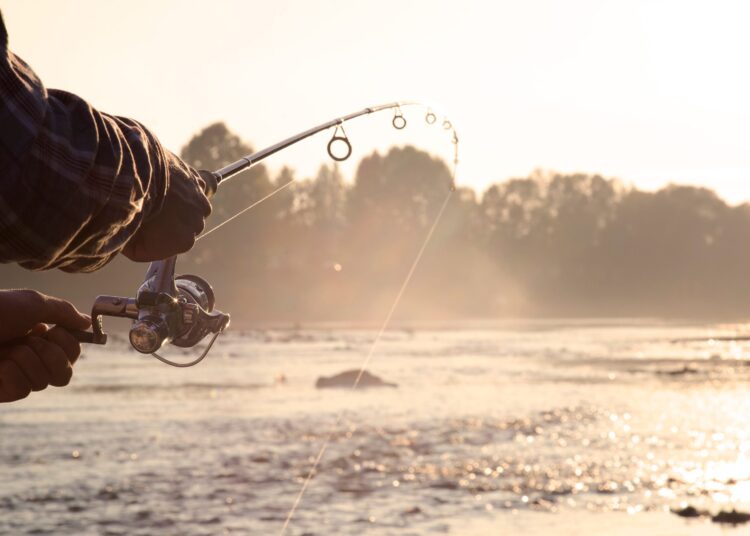We may earn revenue from the products available on this page and participate in affiliate programs. Learn more ›
Monofilament and fluorocarbon line look identical side by side. In fact, unless you are a seasoned angler, you’d be hard-pressed to feel the difference between the two when casting, working lures, or fighting fish. The differences between monofilament vs fluorocarbon, however, are significant. And the unique properties of each line also explain why they’re priced so differently in the tackle shop.
So, do you really need to spend extra on fluorocarbon? Will opting for monofilament really cost you fish? Like many things in fishing, there’s no definitive answer because it all depends on how you’re fishing, the water conditions, and the target species. Understanding the pros and cons of monofilament vs fluorocarbon, however, will make you better prepared to spool up properly for whatever you’re chasing on your home water.
Monofilament vs Fluorocarbon
Monofilament Line
- Monofilament Pros: Most affordable type of fishing line, good abrasion resistance
- Monofilament Cons: Often kinks and coils due to memory. Stretch can hinder long-distance hook sets
In 1937, the DuPont Company created the first synthetic nylon monofilament fishing line using material extracted from coal. At the time, Dacron and linen lines were most popular, but shortly after the company began marketing the product to the public in 1939, the path was set for a monofilament takeover. The material and extrusion process that created nylon monofilament would be refined over the next few decades, and it would reign supreme until the mid-1990s.
When it comes to monofilament vs fluorocarbon, monofilament is the least expensive. You can buy an entire spool for as little as $5, and the price of a standard spool that would fill a freshwater reel rarely exceeds $12. What’s important to consider, however, is that monofilament is now so easy to make, and so many companies produce it, price often dictates quality.
One of the biggest issues with monofilament is memory—especially with bargain or off-brand mono. This line tends to conform to the shape of the spool it’s on, which means when you cast, it comes off the reel in coils. This can hinder casting distance as well as create knots and line twist. The lighter the monofilament, the less memory it has, making memory a more common problem with lines testing at 10 pounds or more. But I’d still recommend buying higher-end mono and looking for “low memory” stamps on the packaging.
Though monofilament has fallen out of favor a bit with many modern anglers, it still has benefits. It has good abrasion resistance, meaning it can be rubbed against hard structure during a fight without instantly severing. Its suppleness helps it maintain excellent knot strength and makes it easier to tie knots and cinch them down properly than it is with stiffer fluorocarbon. Monofilament also floats, making it the ideal choice for fishing with topwater lures. Its ability to stretch comes in handy when dealing with big, strong fish like blue catfish that predominantly lean on their weight instead of speed. Putting too much pressure on them with stiffer, less forgiving line can easily cause the hook to pull out or even bend straight.
Fluorocarbon Line
- Fluorocarbon Pros: Disappears underwater, very strong and abrasion resistant
- Fluorocarbon Cons: Stiffer than monofilament, higher cost, more difficult to tie knots
Fluorocarbon line was invented by Japanese company Seaguar in the early 1970s, though it really didn’t gain a foothold in the U.S. until the 1990s. While it’s created in a process similar to monofilament extrusion, fluorocarbon is made by mixing hydrogen, carbon, and fluoride, which behave much differently than the nylon used in monofilament.
Whereas monofilament can absorb sunlight and glow underwater—which can potentially alert fish that something’s up—fluorocarbon disappears. It was this ability that boosted its popularity in the U.S. as increased pressure made fish more wary, and being stealthy in clear water became critical among tournament anglers. The chemical properties of fluorocarbon vs monofilament also made it significantly stronger as well as more abrasion resistant. Fluorocarbon’s early flaw, however, was stiffness.
For many years, fluorocarbon was primarily used as a leader material. This meant you’d only add a few feet to the end of your main line. In that application, the stiffness was less of an issue, but if you were to fill an entire spool with even the best fluorocarbon fishing line, it would cast poorly. That stiffness and inability to conform also reduced its knot strength a bit. Luckily over time, line manufacturers figured out how to produce lighter, thinner, more responsive fluorocarbon that would cast well and allowed you to use it to fill an entire spool.
Read Next: The Best Fishing Lines for Trout
It’s still slightly stiffer than monofilament, though fluorocarbon tends to have less memory, and while it may take a little getting used to if you’ve been using monofilament, the benefits in terms of helping you fool and land more fish outweigh any of its minor cons. It’s particularly useful in any type of finesse presentation where you want your lure to look as natural as possible to the fish. Likewise, it’s great when casting dead baits, as its ability to vanish makes it appear as though your offering is sitting on the bottom untethered.
Monofilament vs Fluorocarbon: Frequently Asked Questions
What are the disadvantages of fluorocarbon?
Fluorocarbon is more expensive than monofilament. It is also stiffer, making it harder to tie and cast. That said, many manufacturers have learned to make fluorocarbon that is more flexible and better for casting.
Why is fluorocarbon more expensive than monofilament?
Fluorocarbon is more difficult to manufacture than monofilament, making it more expensive.
What is the best leader, mono or fluorocarbon?
Fluorocarbon is one of the best fishing lines for making a leader. Fluorocarbon is more abrasion-resistant and nearly invisible underwater. It can be slightly more difficult to tie knots in fluorocarbon, but the pros outweigh the cons.
Credit: Source link



